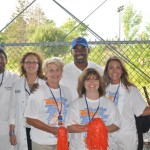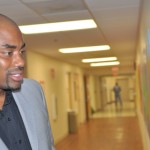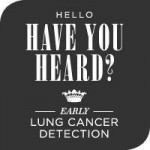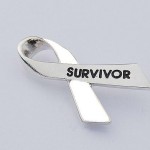Matt Hiznay is Changing the Face of Lung Cancer
Monday, July 2nd, 2012 My name is Matt Hiznay, and I am 25 years old. I am a lung cancer survivor. I am the first child of Jim and Mandie Hiznay. I have a younger sister, Katie, and a younger brother, Patrick. I grew up in Poland, Ohio, and graduated from John Carroll University in University Heights, Ohio. It was there I met my girlfriend, Ally Stojkoska. We met in freshmen biology class and began dating going into our junior years. After college, I enrolled in medical school at the University of Toledo, while Ally was off to pharmacy school at Ohio State University. These people have been with me on my entire journey with lung cancer. I would not be here today without them.
My name is Matt Hiznay, and I am 25 years old. I am a lung cancer survivor. I am the first child of Jim and Mandie Hiznay. I have a younger sister, Katie, and a younger brother, Patrick. I grew up in Poland, Ohio, and graduated from John Carroll University in University Heights, Ohio. It was there I met my girlfriend, Ally Stojkoska. We met in freshmen biology class and began dating going into our junior years. After college, I enrolled in medical school at the University of Toledo, while Ally was off to pharmacy school at Ohio State University. These people have been with me on my entire journey with lung cancer. I would not be here today without them.
I was employed in a lab in the summer of 2011. Towards the end of July 2011, I developed a persistent, dry cough. Because I was going home about 10 days later, and I knowing that I had a past history with summertime allergies, I simply swallowed some cough drops and planned to bring it up at my yearly physical at the beginning of August. My cough worsened in August, and eventually a lymph node swelled up on the left side of my neck. It was removed and biopsied. My life forever changed on Wednesday, August 17, 2011. I was told on that day that I had cancer.
I travelled to the Cleveland Clinic on August 26 to see Dr. Nathan Pennell, a thoracic oncologist. I learned my grave diagnosis: stage IV adenocarcinoma of the lung. It was decided that I would begin intravenous chemotherapy six days later. My cancer was ravaging my body. It had spread into both lungs, into all the lymph nodes in my chest, and into my breastbone. Because of my cancer’s advanced state, it caused quite a list of complications in my body. Dr. Pennell decided that I was too weak to begin chemotherapy on September 1 and admitted me to the hospital. I remained in the Cleveland Clinic for three weeks, battling for my life.
The cancer created a massive fluid buildup around my lungs and my heart. In the early morning of September 2, I fell into respiratory failure, or “coded.” Simply put, my body was losing to the cancer, and fast; I was dying. I was transferred to the intensive care unit, where quick action by the doctors there drained the fluid from around my heart and I stabilized. I was placed on a ventilator because I could not breathe on my own. Tubes were placed in my chest and around my heart to drain the built up fluid. I developed blood clots in both of my lungs. I lost 30 pounds in three weeks. Dr. Pennell later told me that I experienced all the complications a lung cancer patient experiences – but whereas they usually occur over several years, mine all occurred in a matter of five days.
My luck forever changed on September 9. Back on August 26, the day I was diagnosed with lung cancer, Dr. Pennell recommended running a test for a specific genetic mutation that was currently under extensive study. This mutation caused a gene called anaplastic lymphoma kinase, or ALK for short, to become “turned on with no off switch.” This continual state of activity causes tumors to form, survive, and spread in lung cancer patients. Dr. Pennell sent a frozen section of my previously removed lymph node to see if I had this specific genetic mutation. This test is done out west and takes 14 days for a result. After two long weeks, and my near-death, the results showed I was a match for the mutation.
The ALK mutation is so significant because on the day I was diagnosed with lung cancer, the Food and Drug Administration approved a new form of chemotherapy for ALK-positive lung cancer patients. As a matter of fact, the drug I am on won early approval by the FDA and was released six weeks earlier than the scheduled date. I thank God every day for that, because I doubt I would have survived another six weeks without it. This miracle drug, called crizotinib, blocks the mutated ALK gene in my cancer cells. Crizotinib is not your typical chemotherapy. Whereas traditional, intravenous chemotherapy attacks all fast-dividing cells, whether the cells are cancerous or not, crizotinib attacks only the cancerous cells in my body. Crizotinib saved my life.
I began crizotinib on September 10, after the drug was overnighted to Cleveland thanks to the dedicated efforts of the Taussig Cancer Institute and my mother. After I began crizotinib, the fluid around my lungs and heart began to disappear. I slowly regained my strength. My draining tubes were removed and I eventually began to walk again. Finally, I was discharged from the Cleveland Clinic on September 21 and returned home for the first time in three weeks. Dr. Rendell Ashton, the intensivist who directed my care in the ICU, later told me that I was the sickest patient he had ever seen make it out of the ICU alive. On Thursday, November 10, 2011, two months to the day since I began crizotinib, Dr. Pennell informed me that my lung cancer had had a complete response to my treatment. A complete response means that no tumors can be seen on a CT scan and that my cancer was in remission. I went from stage IV lung cancer to cancer-free in two months.
I noticed a swelling on the left side of my neck near the middle of May 2012. A needlepoint biopsy on May 11, 2012 revealed my cancer had had a recurrence. I was referred to Dr. Ross Camidge at the University of Colorado Hospital in Aurora, Colorado. Dr. Camidge is widely regarded as one of the top experts on ALK-positive non-small lung cancer in the United States. He enrolled me in a clinical trial of a drug that acts as the “second generation” of crizotinib. It is believed that some of my cancer cells have become resistant to crizotinib. It is hoped that this new drug will block the resistant cells’ ALK gene in the same previous manner. I will know for certain sometime after my PET scan on July 5, 2012. Until then, I thank everyone for their constant prayers and support.
.jpg)






